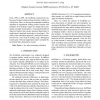Free Online Productivity Tools
i2Speak
i2Symbol
i2OCR
iTex2Img
iWeb2Print
iWeb2Shot
i2Type
iPdf2Split
iPdf2Merge
i2Bopomofo
i2Arabic
i2Style
i2Image
i2PDF
iLatex2Rtf
Sci2ools
89
Voted
IGARSS
2010
2010
Iceberg size and orientation estimation using SeaWinds
From 1999 to 2009, the SeaWinds scatterometer has been used to detect and track large Antarctic icebergs on a daily basis. Here, we develop an automated estimation algorithm to supplement iceberg position reports with estimates of the iceberg's major axis length, minor axis length, and angle of orientation. A maximum-likelihood objective function that relates measured backscatter to model-based simulated backscatter is developed. The utility of the estimation approach is analyzed in simulation and via a case study of iceberg A22a. Subsequent results agree with and supplement reports compiled by the United States National Ice Center.
Related Content
| Added | 13 Feb 2011 |
| Updated | 13 Feb 2011 |
| Type | Journal |
| Year | 2010 |
| Where | IGARSS |
| Authors | Keith M. Stuart, David G. Long |
Comments (0)

